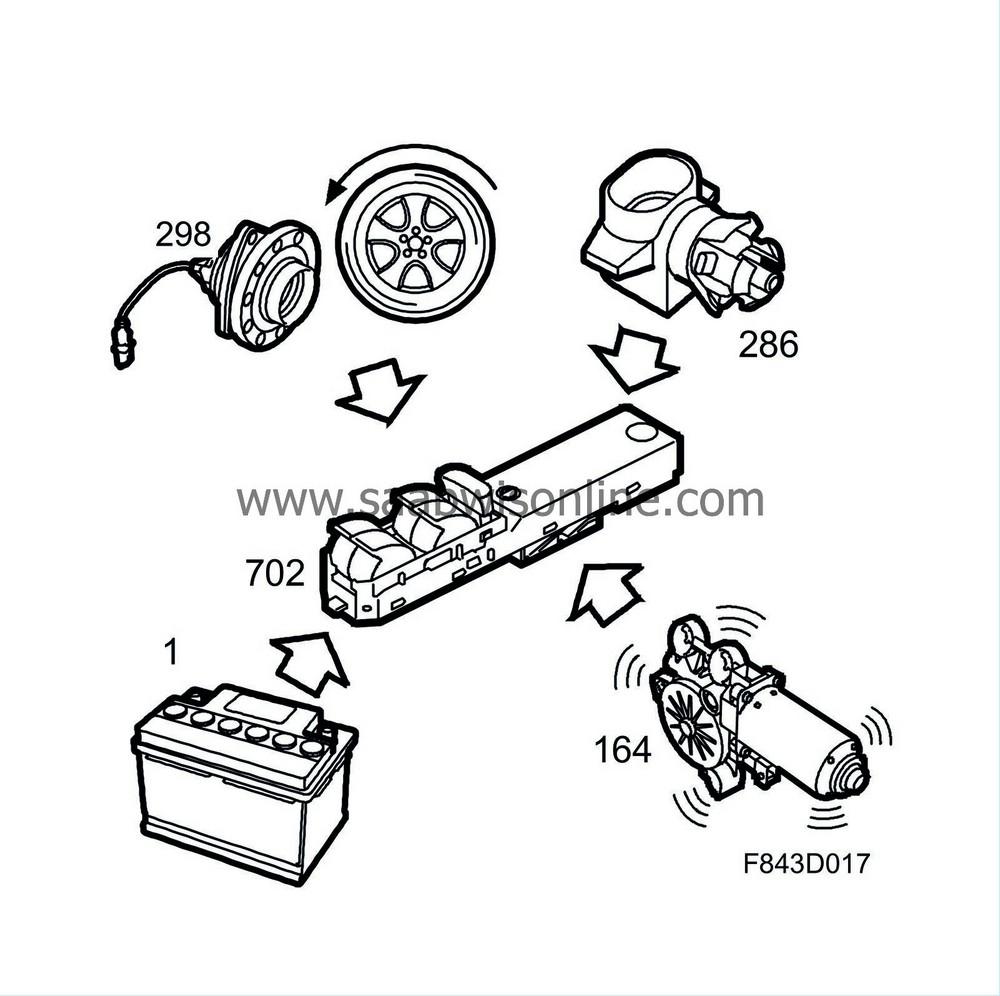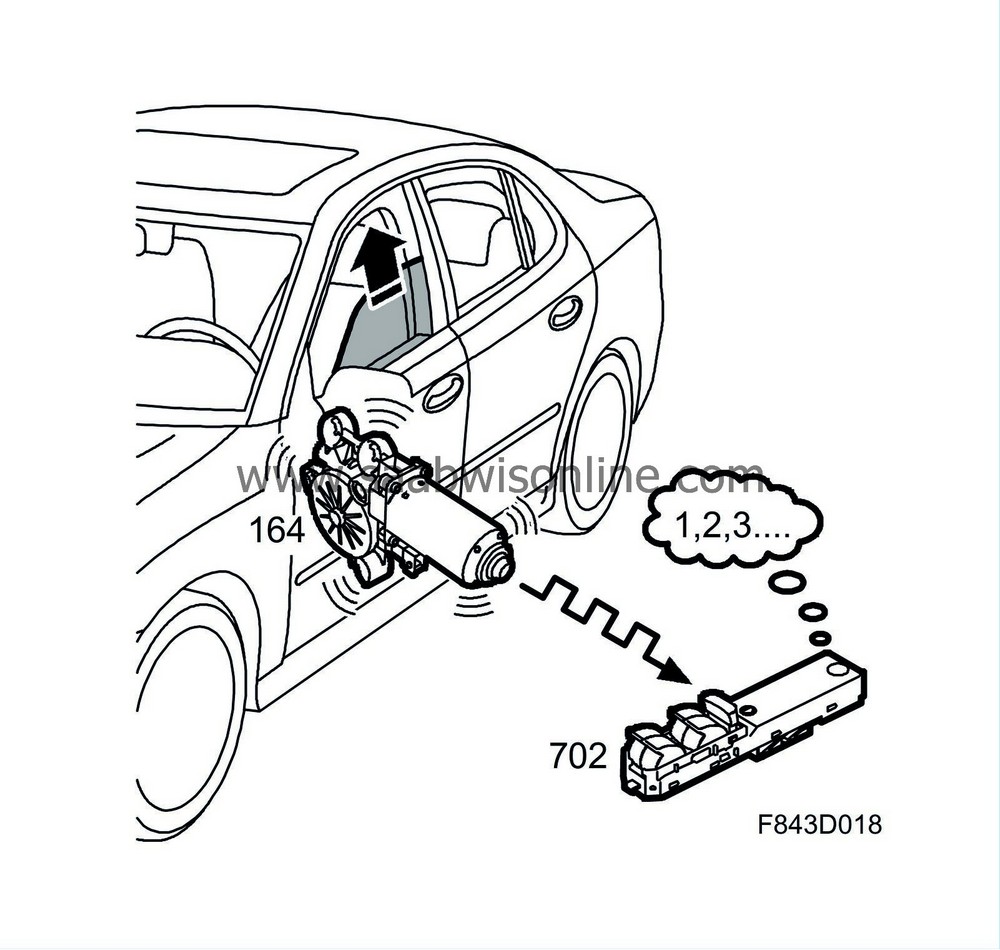Electrically operated window lifts, detailed description
|
|
Electrically operated window lifts, detailed description
|
The window lifts can be operated when the ignition key is ON as well as when the criteria for the
comfort function
are fulfilled. The key position is identified by CIM. To operate the rear window lifts, the blocking function must not have been activated with the button in the driver's door.

The DDM sends a bus message regarding disengagement. If the rear window switches are disengaged, the illuminated switch on the driver's door will change colour to orange and the rear door window switches will cease to be illuminated. The DDM reads the message from the BCM regarding steering wheel position and decides which of the 4 switches is for the driver's door. This button is configured to activate the output to the window lift motor in the driver's door. The status of the other buttons is transmitted on the bus. The other door control modules activate their motor outputs from the bus message from the DDM or their respective switches.
|
Standard electrically operated window lifts
|
If the conditions for running the motor are fulfilled, the door control module will read the button status and bus message and directly activate the motor output with the appropriate polarity. During express opening, the motor is activated constantly. The door control module identifies the end position of the window by measuring the voltage of the output. The front window outputs can be activated for a maximum of 7 s and the rear window output for 9 s.

|
Electrically operated window lifts with "Express closing"
|
In the button positions "Up/Down/Express opening" the windows function in the same way as standard windows. "Express closing" allows a window to be closed automatically but will stop the window and open it slightly if a resistance is detected. The pinch protection function is active if the window is closed with the button in the door or during comfort closing. Information about motor position and speed, motor current consumption, vehicle speed (from ECM) and outside temperature (from BCM) are used to determine the presence of a resistance.

The 2 Hall sensors together emit a pulse every quarter of a turn of the motor. The normal characteristics for window speed and current (resistance of window) are stored in the memory and adapted to compensate for wear and other normal changes with age. An obstruction (pinched object) is detected by sensing that the window closing speed is significantly reduced or that the motor current is exceeding the permitted adapted value. The window's adapted speed and current characteristics are continually corrected to account for battery voltage, outside temperature and vehicle speed. At high vehicle speeds or low outside temperatures, for example, a higher motor current and lower window speed must be permitted without tripping the pinch protection.
The pinch protection is disabled immediately before the window closes fully, just as the window enters the upper part of the window frame. If the function were active at this point, the window would open slightly as a result of closing. The travel of the window, based on dead reckoning from the end positions detected by current measurement, is stored in the door control module. Accordingly, it is possible to deactivate the pinch protection accurately and without risk immediately before the window closes completely.
 Warning
Warning
|
|
The trap protection is not active until the window lifters have been calibrated after a power failure.
|
|
|
|
|
|
|
Calibration of pinch protection
|
The end positions and travel must be calibrated following mechanical work affecting the window, the replacement of the motor or door control module, or a loss of power such as when the battery is changed. Before the end positions have been calibrated, "express closing" will be disabled, which also means that comfort closing will not work.

It can be established whether or not a window is calibrated by moving the window operating button to the upper position and then releasing. If the window shuts automatically it is not necessary to calibrate the door control module. Otherwise calibration must be carried out.
Before calibration is carried out pay attention to the following preconditions:
|
•
|
The ignition key must be ON without starting the engine.
|
|
•
|
The supply voltage must exceed 11,5 V
|
|
•
|
The door must be closed.
|
|
•
|
Only one control module may be calibrated at a time owing to voltage variations
|
|
•
|
Calibration can be carried out from either the driver door control module or from the respective door module.
|
Calibration is carried out as follows:
|
Note
|
|
Only one control module may be calibrated at a time owing to voltage variations.
|
|
2.
|
Turn the ignition key to ON with a sound battery.
|
|
3.
|
Open the side window about 15 cm.
|
|
4.
|
Raise the window completely and hold the button for at least 1 second after the window has stopped. Release the button and the window will now go down by itself.
|
|
5.
|
Wait at least one second.
|
|
6.
|
Drive the window fully up and hold the button in position until closing is confirmed with a sound signal.
|





 Warning
Warning

